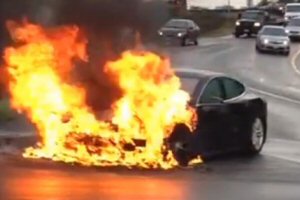Are LENR Processes Causing the Samsung Battery Fires?

Tesla Model S on Fire
Oct. 13, 2016 – By Steven B. Krivit –
On Tuesday, the New York Times reported that Samsung has no idea why the lithium-ion batteries in its Galaxy Note 7 smartphones continue to intermittently burst into flames and spontaneously explode. Low-energy nuclear reaction (LENR) theorist Lewis Larsen, in Chicago, told New Energy Times that LENRs may be one of several factors that can be triggering these fires.
A LENR event inside a battery could create a microscopic ball of ionized plasma at 4,000-6,000 degrees Celsius, which is hot enough to ignite any materials in the battery.
“You have everything you need in there to potentially trigger LENRs,” Larsen said. “You have a source of hydrogen, lithium, metals, and very high electric fields on the surfaces of anodes and cathodes. In advanced batteries, the electrodes are prevented from internally shorting by a plastic separator that may be only 1/1000 of an inch thick. Sufficiently high electric fields, irrespective of LENRs, can break down the separator and trigger a short.”
Larsen has been tracking unexplained lithium-ion battery fires — in planes, automobiles, laptops, and e-cigarettes — since 2010. He told New Energy Times that, as the energy-density capacity of these batteries increases, so does the risk of triggering LENRs.
“When Samsung went from the Galaxy 5 to the Galaxy 7, they increased the battery capacity 15% and changed the chemistry,” Larsen said. “They did this to increase the operating life between recharges, to compete with Apple’s iPhone.”
In 2013, lithium-ion battery fires in Boeing Dreamliner planes made headlines. The batteries are located in the front and rear avionics bays, two key nerve centers for the plane. Worldwide restrictions on transporting lithium-ion batteries by air soon followed.
Also that year, a Tesla Model S car burst into flames on a highway near Seattle, Washington. According to journalist Hannah Elliott, writing for Forbes, Tesla claimed that the fire was caused by “the direct impact of a large metallic object” lying in the roadway. Tesla said the object pierced the car’s armored underbody.
When Elliott asked pointed questions to Tesla’s director of global communications, Elizabeth Jarvis-Shean, Elliott got no answers. Specifically, Jarvis-Shean declined to answer Elliot’s questions “What was the object? How was something so big able to apparently disappear from the site of the alleged crash?”
The Associated Press reported that “a trooper who responded to the scene was unable to locate any objects on the roadway, but [Washington state] Department of Transportation workers did observe some debris near the scene.” No large metallic object was ever reported found.
In August this year, the U.S. Navy’s Naval Safety Center, according to the Navy Times, issued a memo recommending a full ban on e-cigarettes, which rely on lithium-ion batteries. The Navy Times reported that the devices have led to a dozen injuries since 2015, seven of them on Navy ships.
“The Naval Safety Center concludes that these devices pose a significant and unacceptable risk to Navy personnel, facilities, submarines, ships, vessels and aircraft,” the memo reads, as quoted by the Navy Times.
Lithium has long been recognized as an important reactant for LENR experiments, which, like lithium-ion batteries, are often designed as electrolytic cells. Isotopic post-mortem analysis of the burned lithium-ion batteries likely would provide evidence to determine whether LENRs are taking place inside these chemical batteries.
Related News:
Feb. 12, 2013 – LENR, Dendrites and Perhaps Dreamliner Battery Fires
Feb. 2, 2013 – Larsen Speculates LENRs Are Triggers for Lithium-Ion Battery Fires
Jan. 17, 2013 – Are Nuclear Reactions Causing Boeing Dreamliner Battery Fires?
Larsen Slide Presentations
Sept. 25, 2013 – Battery-Field Failures Can Occur in E-Cigarettes
Oct. 3, 2013 – Brief Review of Tesla Model S Battery Thermal Runaway
Oct. 16, 2013 – Technical Analysis of Tesla Model S Battery Thermal Runaway
April 14, 2016 – Energy Density of Lithium-Based Batteries May Be Approaching Safe Limits
Questions? Comments? Submit a Letter to the Editor.

